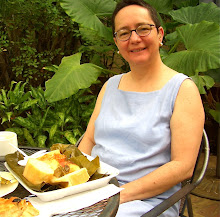
 After we had lived in Managua for several months, we visited Casa Ben Linder in Barrio Monsenor Lezcano for one of their Thursday morning charlas. I've written in a previous post (April 11, 2008) about Ben Linder himself, but today I want to concentrate on the fabulous murals that have been painted at the Casa Ben Linder house.
After we had lived in Managua for several months, we visited Casa Ben Linder in Barrio Monsenor Lezcano for one of their Thursday morning charlas. I've written in a previous post (April 11, 2008) about Ben Linder himself, but today I want to concentrate on the fabulous murals that have been painted at the Casa Ben Linder house.Most of the murals were painted in the late 1980's or the 1990's, with the exception of the mural above. When I was there on a research and buying trip in 2006, I was able to capture this mural in process by Nicaraguan artist Julie Aguirre. Julie is known for her work picturing the lives of Nicaraguan women, and this mural shows a panoramic view of a village with many women, men and children. This is the second mural that Julie has painted on this surface -- the first was ruined by a shellac that was used to cover the painting.
 Several works by Orlando Sobalvarro, one of the leading painters of Nicaraguan, are included in the feast of mural art at Casa Ben Linder. Sobalvarro was born in 1943 in Chontales, and became one of the founders of the Praxis Group in Nicaraguan art during the Sandinista period.
Several works by Orlando Sobalvarro, one of the leading painters of Nicaraguan, are included in the feast of mural art at Casa Ben Linder. Sobalvarro was born in 1943 in Chontales, and became one of the founders of the Praxis Group in Nicaraguan art during the Sandinista period. He links art and politics, and is considered a master interpreter of allegory and abstract symbolism. In David Craven's book, Art and Revolution in Latin America (2002, page 231), Sobalvarro is quoted, "It is important that the concepts of abstraction be understood by the general public, since the same pictorial qualities apply to painting as to political propaganda." Casa Ben Linder is fortunate to have several works by Sobalvarro. These works are in the form of tile petroglyphs adhered to the walls of the Casa Ben Linder compound.
He links art and politics, and is considered a master interpreter of allegory and abstract symbolism. In David Craven's book, Art and Revolution in Latin America (2002, page 231), Sobalvarro is quoted, "It is important that the concepts of abstraction be understood by the general public, since the same pictorial qualities apply to painting as to political propaganda." Casa Ben Linder is fortunate to have several works by Sobalvarro. These works are in the form of tile petroglyphs adhered to the walls of the Casa Ben Linder compound. The majority of the murals at the Casa Ben Linder chronicle Ben Linder's life, and heroes of pacifism, equality, charity and non-violence. The murals of Ben's life where painted by Thelma Gomez and Freddy Gaitan. One mural shows Ben with his father, discovering electricity, illustrating Ben's interest in science and his eventual education as an engineer. This mural is part of a series by Thelma and Freddy about Ben Linder.
The majority of the murals at the Casa Ben Linder chronicle Ben Linder's life, and heroes of pacifism, equality, charity and non-violence. The murals of Ben's life where painted by Thelma Gomez and Freddy Gaitan. One mural shows Ben with his father, discovering electricity, illustrating Ben's interest in science and his eventual education as an engineer. This mural is part of a series by Thelma and Freddy about Ben Linder.

Another mural takes a more political angle, and shows Ben confronting a dragon. The dragon symbolizes the "beast", or US policy toward Nicaragua, including US support of the Contras. Ben is visible atop a hill with a grasshopper in his hand, representing hope in Nicaraguan imagery.


A number of the murals present portraits of heroes of pacifism and charity, and were painted by a Dutch artist, Diederick Grootjans. The absolute accuracy of this attribution is not confirmed; however, Padre Miguel D'Escoto, who was the initiator of many of the art projects and activities at Casa Ben Linder during the 1990's, believes this to be the artist's name (personal communication from Judy Richardson through phone interview, January 20, 2006).
 The series includes Tolstoy and a Nicaraguan campesino woman (above left), Martin Luther King and a Nicaraguan woman (above right), Jesus Christ and Dorothy Day (right), an American journalist who was known for her social justice campaigns and who became a devout Catholic later in life.
The series includes Tolstoy and a Nicaraguan campesino woman (above left), Martin Luther King and a Nicaraguan woman (above right), Jesus Christ and Dorothy Day (right), an American journalist who was known for her social justice campaigns and who became a devout Catholic later in life.These portrait murals are reportedly part of a series focused on Tolstoy. Padre Miguel D'Escoto had a great respect for Tolstoy and the path of non-violence, and originally suggested this series to highlight various peacemakers.
In 2005, a series of note cards was published of these murals, and may still be available through the Casa Ben Linder staff.
I would like to thank Penn Garvin and Judy Richardson for sharing their knowledge about these murals and the history of the Casa Ben Linder.

No comments:
Post a Comment